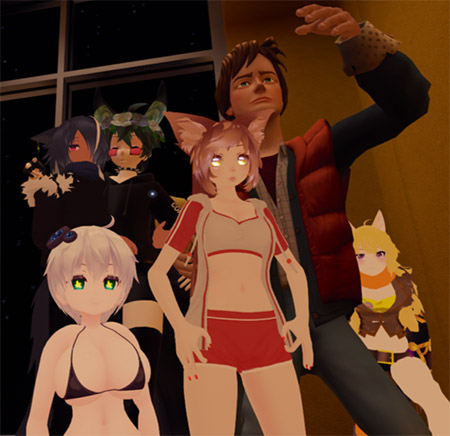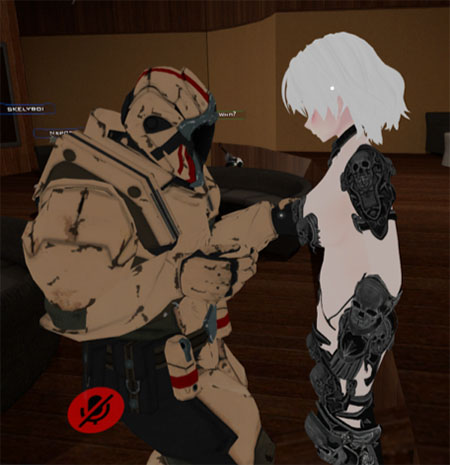Content warning from author: This post will have instances of sexism, transphobia, and sexual violence.
I noticed a masculine voice near me say: “wow Wow WOW!” I turned my body to see a couple of masculine avatars looking at me, or rather looking at my breasts. I said nothing, afraid I might be “found out” — that my voice wouldn’t quite match what the body of my avatar “should” have. As my avatar stood there, blinking in silence, one of the masculine avatars got closer and began to rub my body, taking particular interest in my breasts. I looked down and shared eye contact with him, and he said “Don’t worry. It’s ok, it’s VRChat. This is what happens. You won’t really feel anything anyway.” The others did the same.

A group of masculine avatars touch the author’s avatar’s breasts. Image by author.
I activated my microphone, the only form of communicating in VRChat, and said to the three avatars “please back away, this is overwhelming.” They stopped. One of them said to me “oh! You’re a trap, let me correct this!” he shaped his hand to resemble the fact that he was holding onto a penis, my penis, and pretended to jerk off what “should be” between the legs of my avatar. They began to chuckle and then walked away in laughter. For the residents of VRChat, this is a fairly common interaction.
In this blog post, I attempt to define the feelings that impress binary gender expectations in place with the concept of hetero-comfortability from my ongoing ethnographic work in VRChat. Hetero-comfortability is a process of recognition, where feelings of familiarity — historically established through hetero-conditioning — create impressions that allow one to find comfort in the continuing appearance of hetero-signifiers. As Sara Ahmed (2004b) notes, “To follow the rules of heterosexuality is to be at ease in a world that reflects back the couple form one inhabits as an ideal.”
If it’s the case that gendered bodies follow the rules of heterosexuality, I (and Sundén) wonder “what then happens when (avatar) bodies fail to regulate the comfort of heteronormative spaces?” (Sundén 2010).
Being a queer resident, my presence in a feminine virtual body is able to break the learned repetitions of heteronormative expectations for feminine bodies given my “dissonant voice.” Responses to maintain heteronormative space are triggered by other residents. In my case, this was met with harassment, using terminology (trap) that is often wielded to incite violence towards trans women.
Streaming and Avatar Creation in VRChat
In order to begin to understand how hetero-comfortability informs the interaction between residents, we should first note how avatars take form in VRChat. In VRChat, the residents can discover virtual rooms and content which have been uploaded by both the VRChat production team, as well as the residents themselves. With the right expertise, VRChat residents are allowed to design avatars in 3D modeling software, and import those avatars into the digital world. The avatar bodies that inhabit VRChat are often created to reflect pop culture icons, memes, ordinary life objects, animals, anime characters, or any remixes and combinations of these.
However, despite a seemingly limitless set of options from which to source ones avatar, feminine bodies and representations are rarely diverse. Anime girls predominantly occupy the servers, while other feminine representations seldom appear. Many of the anime girl avatar models are over-sexualized, voluptuous, and vaguely-of-age.

Avatars hanging out in VRChat. Image by author.
This sexualization is not limited to the platform. Many avatar designers are known for posting avatar creation videos and live streams on platforms like Twitch and YouTube. Within these live streams, the avatar designers showcase their own creation process for designing new avatars. Designers often have high expertise in 3D modelling software as this software is not beginner friendly. Having higher literacy in this software allows a designer to create more intricate avatars which may have improved and complex animations, physics, body parts, and outfits.
Many of the constructed feminine bodies are given physics for their breasts, butts, and hair, so that these body parts can move and flow according to the hyper-feminine gendered, heteronormative standards. Even so, some body parts are given what are called “colliders”, allowing residents to play with and even squeeze their breasts.
In their live stream, designers frequently discuss what physical attributes they like about women’s bodies. As such, the capacity for avatar design has a big effect on the capacity to enforce heteronormative avatars, when the designers prescribe their heteronormative fantasies to the avatar bodies by literally molding specific body parts.
Notably, in live streams, designers often receive feedback and validation from spectators through a live comment feed. Spectators mention that the avatar on-screen, mid-design, need to be cuter or hotter, specifying which body parts need attention to give them the feeling of a cuter, hotter, feminine body. It could be said that they are collectively constructing the female avatar model on-screen.
Affective Avatar Bodies
So, it is evident that feminine avatars in VRChat are a product of collective heteronormative desire produced in the avatar creation process. But, where are the feelings of what gender “should be” generated from?
Thinking about this reminds me of what Sara Ahmed said:
“[…] how the feelings feel in the first place may be tied to a past history of readings, in the sense that the process of recognition (of this feeling, or that feeling) is bound up with what we already know.“ (Ahmed 2004b)
In this, Ahmed argues that affect is something that has resonance in past experiences — affect is then always mediated through the body of the present, in remembrance of past knowledge and experiences. Put differently, what we feel is tied to what we already know.
So, this ethnographic work indicates that knowledge about the way a feminine body should look emerges from feelings, experienced by bodies that have been shaped and informed by past heteronormative experiences about the world, and about how gender is (or, “should be”) performed. By thinking about historical practices and how these affect our knowledge of the body, and thus how we live and experience feelings about normality and comfort from within our bodies, we can start to think about how repeated past actions, embedded in the habits of heteronormativity, shape and materialize external structures like heteronormativity.
As the residents of VRChat become spectators for avatar designers in live streams, they help establish a hetero-comfortable space by inputting their feelings into what is literally constructing the feminine body on-screen. For bodies to give the feeling of hetero-comfortability, they must reflect comforts of heteronormativity through binary sexually-dimorphic bodies.
Of course, the relational emergence of feelings about gender through interaction is present in the world itself. In line with Ahmed’s (2004a) notion that past experiences are mediated into understandings of the present, Butler (1993) states that it is through the repetition of norms that those normative worlds continue to exist, creating effects of boundary, fixity and surface (along the lines of masculine or feminine bodies). Namely a reiterative process codifies gender onto the surface of the body and relations between bodies. So, thinking about how emotions and the feelings of comfort for heterosexuality plays into body and world creation can help us see how normative power structures shape the maintenance of normative bodies and genders.

A masculine avatar touches a feminine avatar and says “I came to VRChat to see anime titties.” Image by author.
For VRChat, this is largely mediated by technological affordances which bring out social practices that may often be impossible in other worlds. For example, VRChat allows its residents to have full body control of their avatars using virtual reality technology. As such, avatars may tilt their heads, reach their arms out, shape their hands, and even control certain fingers. With this, the residents may hug, lean in for a kiss, punch, kick, and touch parts of a stranger’s body. The residents are able to “enjoy” themselves with feminine bodies in ways intended by hetero-comfortability which continue to perpetuate such standards. Evidently, VRChat enables new avenues for hetero-comfortability in its ability to provide so many avenues for offline hetero life to be re-performed online. Not many other digital worlds allow such potential for embodied experience given that their avatars are restricted to the predefined performances implemented by the producers of that world.
Conclusion
With its extra technological affordances, features such as voice chat and body-tracking, forms of breaking hetero-comfortability (in using voice chat), and forms of violence (screaming, bodily gestures, and space-taking) make VRChat a complex space to understand the responses evoked by hetero-comfortability between the interactions of its residents.
For the residents of VRChat, the feelings of hetero-comfortability—produced through embodied expectations that emerge as these feelings—continuously make impressions onto avatar bodies. Through repetitions of historical practices of patriarchy and hetero-norms, residents perpetuate the harassment and over-sexualization of the feminine. Whereas for queer residents, who “fail” to reiterate these historical practices, violence is justified by the belief that hetero-comfortable spaces are being taken away from non-queer residents.
In understanding these interactions through hetero-comfortability, we can begin to uncover how heteronormativity displays violence towards the residents who become othered through the practices of heteronormative gendering.
References
Ahmed, S. (2004a). “Affective economies.” Social text, 22(2), 117-139.
Ahmed, S. (2004b). The cultural politics of emotion. Routledge.
Butler, J. (1993). Bodies that matter. Routledge.
Sundén, J. (2010). “A sense of play: affect, emotion and embodiment in ‘World of Warcraft.'” in Working with Affect in Feminist Readings, Eds. Marianne Liljeström and Susanna Paasonen. Routledge.
